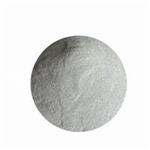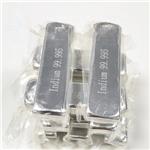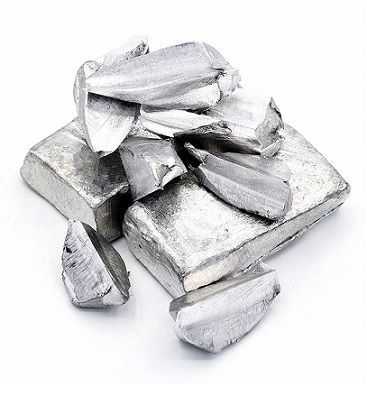- Indium
-

- $6.00 / 1KG
-
2024-04-12
- CAS:7440-74-6
- Min. Order: 1KG
- Purity: More than 99%
- Supply Ability: 2000KG/Month
- Indium
-

- $8.00 / 1KG
-
2024-03-29
- CAS:7440-74-6
- Min. Order: 1KG
- Purity: 99%
- Supply Ability: g-kg-tons, free sample is available
- Indium
-

- $0.00 / 1g
-
2023-12-25
- CAS:7440-74-6
- Min. Order: 1g
- Purity: 99%
- Supply Ability: 1000000
|
| Product Name: | Indium | | Synonyms: | INDIUM WIRES;INDIUM BAR 99.999+%;INDIUM, PIECES, 99.99%;INDIUM, FOIL, 0.127MM THICK, 99.99%;INDIUM SHOT 2 -5MM DIAM. 99.99%;INDIUM, WIRE, 2.0MM DIAM., 99.999%;INDIUM, ROD, 10MM DIAM., 99.9998%;INDIUM, FOIL, 0.25MM THICK, 99.99% | | CAS: | 7440-74-6 | | MF: | In | | MW: | 114.82 | | EINECS: | 231-180-0 | | Product Categories: | Indium;Metal and Ceramic Science;Metals;Catalysis and Inorganic Chemistry;Chemical Synthesis;IndiumMetal and Ceramic Science;IApplication CRMs;ICP CRMs;Alphabetic;Analytical Standards;ICP-OES/-MS;ICPSpectroscopy;Spectroscopy;Inorganics;metal or element | | Mol File: | 7440-74-6.mol |  |
| | Indium Chemical Properties |
| Melting point | 156.6 °C (lit.) | | Boiling point | 2000 °C | | density | 7.3 g/mL at 25 °C (lit.) | | vapor pressure | <0.01 mm Hg ( 25 °C) | | Fp | 2072°C | | storage temp. | no restrictions. | | solubility | soluble in acid solutions | | form | wire | | Specific Gravity | 7.31 | | color | White | | resistivity | 8.37 μΩ-cm | | Water Solubility | insoluble | | Merck | 14,4947 | | Exposure limits | ACGIH: TWA 2 ppm; STEL 4 ppm
OSHA: TWA 2 ppm(5 mg/m3)
NIOSH: IDLH 25 ppm; TWA 2 ppm(5 mg/m3); STEL 4 ppm(10 mg/m3) | | Stability: | Stable. Incompatible with strong acids, strong oxidizing agents, sulfur. | | LogP | 5.9 at 22℃ | | CAS DataBase Reference | 7440-74-6(CAS DataBase Reference) | | NIST Chemistry Reference | Indium(7440-74-6) | | EPA Substance Registry System | Indium (7440-74-6) |
| | Indium Usage And Synthesis |
| Description | Indium lies in Group 13 (13th vertical column of the periodic table). it shows a wide variety of properties. It is considered to be metal of the 'poor metals' group.

Indium (symbol Ga; CAS# 7440-74-6) is widely used in the electronics industry, its radioisotopes are used for diagnostic imaging in medicine. Though this element is not essential for human nutrition, it is widely distributed in low concentrations in the environment (Smith et al., 1978).
Radioisotopes of indium have been used to label phagocytes and lymphocytes to localize inflammatory lesions (Dudley and Marrer, 1952; Abrams and Murrer, 1993). Despite early optimism, neither element has found wide use as a treatment for malignancies. | | Chemical Properties | Indium is a rare, lustrous silver-white metal with atomic
number 49 and In as its atomic symbol. It is widely distributed
in the Earth’s crust in minute quantities (0.1 ppm) and is also
found in the hydrosphere. Indium belongs to group IIIA in the
periodic table. It was found and spectroscopically identified as
a minor component in zinc ores and isolated in 1863 by
Ferdinand Reich and Theodore Richter. Indium is so named
for the indigo blue color that its salts lend to flames. Indium
resembles tin in its physical and chemical properties and to
some extent in its toxicological properties. It is extremely soft
and malleable, with a Brinell test hardness of less than 1 and a
Mohs scale hardness of 1.2. In the electromotive series, it
appears between iron and tin and does not decompose inwater
at boiling temperature. It is stable in air, but when heated, it
burns with a nonluminous, blue-red flame yielding indium
oxide. The surface of indium remains bright up to its melting
point; above this, it forms an oxide film.
Indium is flammable in the form of dust, yielding indium
oxide when exposed to heat or flame. Mixtures of indium
with sulfur ignite when heated. Indium reacts explosively
with dinitrogen tetroxide plus acetonitrile. Indium exhibits
a violent reaction with mercury(II) bromide at 350°C. Indium
is unaffected by water, is attacked by mineral acids, and is
very resistant to alkalies. | | Physical properties | Indium is silvery-white and malleable and looks much like aluminum and tin. However,it is softer than lead. Indium metal is so soft that it cannot be “wiped” onto other surfaces aswith a graphite pencil. Because it is noncorrosive and does not oxidize at room temperatures,it can be polished and will hold its shine better than silver. Its melting point is 156.60°C, itsboiling point is 2,075°C, and its density is 7.31 g/cm3. | | Isotopes | There are a total of 73 isotopes of indium. All are radioactive with relativelyshort half-lives, except two that are considered stable. Isotope In-113 makes up just4.29% of the total indium found in the Earth’s crust. The isotope In-115, with a half-lifeof 4.41×10-14 years contributes the balance (95.71%) of the element’s existence in theEarth’s crust. | | Origin of Name | Indium’s name is derived from the Latin word indicum, meaning “indigo,”
which is the color of its spectral line when viewed by a spectroscope. | | Occurrence | Indium is a rather rare metal. It is the 69th most abundant element, which is about asabundant as silver at 0.05 ppm. Although it is widely spread over the Earth’s crust, it is foundin very small concentrations and always combined with other metal ores. It is never found inits natural metallic state.
Indium is recovered as a by-product of smelting other metal ores such as aluminum,antimony, cadmium, arsenic, and zinc. About 1,000 kg of indium is recovered each year (ora concentration of 1 part indium per 1000 parts of dust) from the flue stacks (chimneys) ofzinc refineries.
Indium is found in metal ores and minerals located in Russia, Japan, Europe, Peru, andCanada, as well as in the western part of the United States. | | History | Discovered by Reich and Richter, who later isolated the metal. Indium is most frequently associated with zinc materials, and it is from these that most commercial indium is now obtained; however, it is also found in iron, lead, and copper ores. Until 1924, a gram or so constituted the world’s supply of this element in isolated form. It is probably about as abundant as silver. About 4 million troy ounces ofindium are now produced annually in the Free World. Canada is presently producing more than 1,000,000 troy ounces annually. The present cost of indium is about $2 to $10/g, depending on quantity and purity. It is available in ultrapure form. Indium is a very soft, silvery-white metal with a brilliant luster. The pure metal gives a high-pitched “cry” when bent. It wets glass, as does gallium. Indium has found application in making low-melting alloys; an alloy of 24% indium–76% gallium is liquid at room temperature. Indium is used in making bearing alloys, germanium transistors, rectifiers, thermistors, liquid crystal displays, high definition television, batteries, and photoconductors. It can be plated onto metal and evaporated onto glass, forming a mirror as good as that made with silver but with more resistance to atmospheric corrosion. There is evidence that indium has a low order of toxicity; however, care should be taken until further information is available. Seventy isotopes and isomers are now recognized (more than any other element). Natural indium contains two isotopes. One is stable. The other, 115In, comprising 95.71% of natural indium is slightly radioactive with a very long half-life. | | Characteristics | Indium has one odd characteristic in that in the form of a sheet, like the metal tin, it willemit a shrieking sound when bent rapidly. Indium has some of the characteristics of othermetals near it in the periodic table and may be thought of as an “extension” of the secondseries of the transition elements. Although it is corrosion-resistant at room temperature, it willoxidize at higher temperatures. It is soluble in acids, but not in alkalis or hot water. | | Uses | Indium’s low melting point is the major factor in determining its commercial importance.This factor makes it ideal for soldering the lead wires to semiconductors and transistors in theelectronics industry. The compounds of indium arsenide, indium antimonide, and indiumphosphide are used to construct semiconductors that have specialized functions in the electronicsindustry.
Another main use is as an alloy with other metals when it will lower the melting point ofthe metals with which it is alloyed. Alloys of indium and silver and indium and lead have theability to carry electricity better than pure silver and lead.
Indium is used as a coating for steel bearings to increase their resistance to wear. It alsohas the ability to “wet” glass, which makes it an excellent mirror surface that lasts longer than mercury mirrors. Sheets of indium foil are inserted into nuclear reactors to help control thenuclear fission reaction by absorbing some of the neutrons. | | Uses | Indium element is used in the synthesis of therapeutic particles containing metal ions; characterized by the use of unique ligand sets capable of making the metal ion complex soluble in biolgical medi
a to induce selective toxicity in diseased cells. | | Uses | In bearing alloys; as a thin film on moving surfaces made from other metals. In dental alloys. In semiconductor research. In nuclear reactor control rods (in the form of an Ag-In-Cd alloy).
Indium can be used as a bandpass filter in the ultraviolet region. It is also used as a solder for contact
at semiconductor et al. due to its comparatively low melting point. It is also utilized as a
medium to cool samples according to its very large thermal conductivity, especially at
low temperatures. | | Definition | A soft silvery metallic
element belonging to group 13 of the periodic
table. It is found in minute quantities,
primarily in zinc ores and is used in alloys,
in several electronic devices, and in electroplating.
Symbol: In; m.p. 155.17°C; b.p.
2080°C; r.d. 7.31 (25°C); p.n. 49; r.a.m.
114.818. | | Definition | ChEBI: A metallic element first identified and named from the brilliant indigo (Latin indicum) blue line in its flame spectrum. | | Production Methods | Mineral sources are most commonly dark sphalerite (ZnS),
marmatite, and christophite (FeS:ZnS). Indium also occurs in small quantities in tin ores, siderite, and manganese and
tungsten ores.Gallium is often associated with indium in zinc
and tin ores. Many sulfide ores of copper, iron, lead, cobalt,
and bismuth contain small quantities of indium. Zinc smelter
flue dusts, in some cases, contain more than 1% indium, and
are the largest commercial source of the metal. Other commercial
sources are plant residues and dross from the refining
of zinc, lead, and cadmium. Indium is recovered from zinc
processing residues by acid leaching followed by chemical
separation from the accompanying elemental impurities such
as zinc, cadmium, aluminum, arsenic, and antimony. Final
purification by aqueous electrolysis of the salts at a controlled
potential yields a product of 99.9% purity. Canada and Peru
supply the greatest amounts of unwrought waste and scrap.
Next in order are Japan, Germany, and the United Kingdom.
The pattern of indium usage, and potential industrial hazard,
is 30% in solders, low-melting alloys, and coatings; 30% in
instrument applications and holding devices; 18% in electronic
components; 6% in nuclear reactor controls; and 16%
in research and other uses. | | Definition | indium: Symbol In. A soft silvery elementbelonging to group 13 (formerlyIIIB) of the periodic table; a.n.49; r.a.m. 114.82; r.d. 7.31 (20°C);m.p. 156.6°C; b.p. 2080±2°C. It occursin zinc blende and some iron oresand is obtained from zinc flue dust intotal quantities of about 40 tonnesper annum. Naturally occurring indiumconsists of 4.23% indium–113(stable) and 95.77% indium–115 (halflife6 × 1014 years). There are a furtherfive short-lived radioisotopes.The uses of the metal are small –some special-purpose electroplatesand some special fusible alloys. Severalsemiconductor compounds areused, such as InAs, InP, and InSb.With only three electrons in its valencyshell, indium is an electron acceptorand is used to dope puregermanium and silicon; it forms stableindium(I), indium(II), and indium(III) compounds. The elementwas discovered in 1863 by FerdinandReich (1799–1882) and HieronymusRichter (1824–90). | | General Description | Soft, ductile, shiny, silver-white metal. Mp: 155.6°C; bp: 2080°C. Density 7.31 g cm-3. | | Reactivity Profile | Indium is a non-combustible solid in bulk form but is flammable in the form of a dust. Reacts with strong oxidizing agents. Reacts explosively with dinitrogen tetraoxide dissolved in acetonitrile. Reacts violently with mercury(II)bromide at 350°C. Mixtures with sulfur ignite when heated. | | Hazard | Indium metal dust, particles, and vapors are toxic if ingested or inhaled, as are most of thecompounds of indium. This requires the semiconductor and electronics industries that useindium compounds to provide protection for their workers. | | Hazard | Metal and its compounds are toxic by
inhalation. | | Health Hazard | Indium (In) and compounds
cause injury to the lungs, liver and kidneys in
animals.
There are no reports of toxicity in humans.
When indium was applied to the skin there was
no evidence of irritation. | | Industrial uses | Indium (symbol In) is a silvery-white metal with a bluish hue, whiter than tin.It is very ductile and does not work-harden, because its recrystallization point is below normal room temperature, and it softens during rolling. The metal is not easily oxidized, but above its melting point, 157 C, it oxidizes and burns with a violet flame.
Indium is now obtained as a by-product from a variety of ores. Because of its bright color, light reflectance, and corrosion resistance, it is valued as a plating metal, especially for reflectors. It is softer than lead, but a hard surface is obtained by heating the plated part to diffuse the indium into the base metal. It has high adhesion to other metals. When added to chromium plating baths it reduces brittleness of the chromium.
The three largest uses of indium are in semiconductordevices, bearings, and low meltingpointalloys. | | Carcinogenicity | Indium has not been tested for its
ability to cause cancer in animals. However, the probable
carcinogenic properties of indium are linked to alterations in
the synthesis and maintenance of enzyme systems that
metabolize organic carcinogens. A compromise in the ability
of these metabolic systems would lead to altered cellular
responses to organic carcinogenic substances. | | Purification Methods | Before use, the metal surface is cleaned with dilute HNO3, followed by thorough washing with water and an alcohol rinse. [D.nges in Handbook of Preparative Inorganic Chemistry (Ed. Brauer) Academic Press Vol I p 856 1963.] | | Structure and conformation | The space lattice of Indium belongs to the tetragonal system and its deformed face centered cubic
D4h (4 atoms within a unit cell) has lattice constants of a=0.4588 nm, c=0.4938 nm, and
In–In=0.324 nm. |
| | Indium Preparation Products And Raw materials |
|